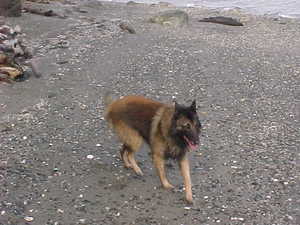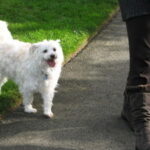“I think of a hero as someone who understands the degree of responsibility that comes with freedom.”
– Bob Dylan
Is your dog born to be free? The stories abound of letting Fido off leash only to have him rush out unruly and wild. Calling him back is not an option nor successful and forget about ever seeing him again if he finds a dog to play with or a group of people to follow. This even happens in one’s own backyard where digging leads to escape and freedom. Freedom comes with a price. Sound familiar? A reliable off leash companion is not only trustworthy, but has mastered off leash training skills.
How do you train a dog to be reliable off leash?
First, evaluate what your dog knows to see if you are ready to begin off leash training.
Do they have a one cue sit, down, stand?
If you say leave it, do they?
Do they stay for 30 seconds while you are out of sight?
Do they come when called on one cue from a long line at 100 feet?
Do they come to you when in the yard off leash on one cue no matter what they are doing?
Can they have continuous eye contact with you when sitting, when down, when standing, when heeling?
Answered yes to all, then you are ready for off leash training.
Answered no, continue to train the skills above.
It is important to note here that some dogs will never be able to be off lead reliably. It doesn’t mean they are any less of a companion, it just means that to let them off lead would be hazardous to their health and well being.
Off leash reliability can be taught to puppies early because they already see you as their educator and guide. You are deserving of the role, so I take advantage of this and teach puppies off lead before on lead. This way I get reliability sooner.
What type of personality is your dog? This will indicate how much work you’ll need to put into training. More independent personalities might challenge your guidance from time to time, while a dependent personality won’t want to be far from you. The latter is the easier one to train for reliability, but the independent dog can be taught and shine. With the independent dog you must be more important than anything in the environment, an undisputed guide and educator and highly reinforcing. With the dependent dog, you already are an anchor in a scary environment.
Here are five training steps for off leash reliability.
Step One. Start your training in a neutral enclosed area. Taking the lead off does not mean your dog leaps away and runs wildly. As you unclasp the lead, you ask your dog to stay or wait. Let them wait a short or a long time. Make sure they have eye contact with you before you give your release cue. Sometimes just clip the lead back on and keep walking, praising the dog for the stay. This must be perfect, because dogs that dash away are not focused on you.
Step Two. Release your dog into the neutral, enclosed area. Wait for them to look back and then say their name ONLY. As they eagerly head back to you either praise or click for that action, and highly reward when they get back to you. Their name will mean something good is coming. At this point practice clipping the lead back on, or releasing them again. Practice at least 10 times and end on success.
Step Three. Release your dog into the neutral, enclosed area. Repeat as above, except this time you are going to add a cue after you call their name. You’ll add come, or sit as they race to you, or down or have them do a trick. You are the dispenser of all fun and reinforcements. They will begin to love this game and you’ll have a high rate of reliability to your cues. When your dog is turning back to check in regularly, add the cue “check in!”
Step Four is enforcing territory boundaries. If you are walking a trail, it is wise to teach your dog to stay on the trail. A dog that races wildly into the brush can also be controlled, but it will take longer and you will really have to know your dog and that the trust is mutual. I had an Irish Setter who was trained from very young to do trail walks. He would head into the brush and disappear, but would come out ahead of us periodically to check where we were. He always knew where we were and he always checked. He was very reliable and so I didn’t worry about him off trail. He was not the type of dog who would bother the wildlife. This type of dog needs to have a strong bond to you and see you as undisputed guide on these walks. These dogs, I have to admit, are rare and so I prefer to have my dog stay with me on the trail. Now I have two Belgian Tervurens, one of each personality described above, and the independent soul darts off the path, but not far and then darts back while the dependent stays with me on the trail only going body deep at times to check things out. The independent dog is the one I have to constantly monitor as he is proofing me all the time.
Step Five is to develop an undisputed and reliable emergency recall. Use a whistle for the independent canine and teach that the whistle means a reward they only get when they hear that whistle is coming. It is something they never get at any other time and it is something they will leave anything to get. When they arrive, you feed for a full 30 seconds, or 10 to 12 treats for a large dog, 7 to 8 for a small dog delivered one morsel at a time. If you have had to use your emergency recall that means Fido must have ventured too far, so ask them to heel beside you, or clip on the leash or release and do some on trail training exercises. It will be well worth the effort as it will keep your dog training and alert to your cues.
Freedom requires responsibility on the part of the dog owner. Freedom does not mean leaving your dog unsupervised to run as they please. Freedom equals trust and results. It means you have a communication system and understand each other. It means you are the undisputed guide. How do you obtain that level of trust, that level of acceptance?
- The dog must have the skills explained above.
- The owner has to be highly rewarding.
- Cues have to lead to reinforcement.
- The owner has to be more rewarding than anything in the environment. Dog Trainer, Susan Ailsby has said it quite succinctly, “You have to be more exciting than spit on a sidewalk.
- The dog has to respect and trust you.
- The dog understands off leash still means you are in charge.
- You have trained your dog to respond to various cues, given once, and highly rewarded.
- You always deliver.
- You are able to read your dog’s body language and respond quickly.
- You constantly watch the environment.
- You are always prepared and bring the tools of training.
Laying the groundwork for reliability takes hard work, and weeks of training, even months. If you look at the process as developing a fine tuned team – your dog(s) and you – then the training will reap huge rewards. If you look at it as a job, get frustrated when things don’t go your way, then it will be fun for no one and you will not achieve reliability because you have not achieved mutual respect and trust.
It makes use of proofing skills. Proofing is how you will know when training efforts are paying dividends.


